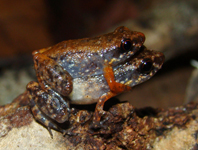Abstract
The hitherto undescribed larva of Holocentropus insignis Martynov 1924 was collected in Denmark, the Netherlands, and Finland. Based on larval morphology and DNA association with adults, we were able to distinguish the larva of H. insignis from other Holocentropus species known to occur in Europe and confirm its identification. We provide morphological features to separate H. insignis from the other known species within the genus and give an updated key to all known European larvae of Holocentropus. Extensive notes on the life cycle, biology, and distribution of H. insignis are given.
References
Chamorro, M.L. & Holzenthal, R.W. (2011) Phylogeny of Polycentropodidae Ulmer, 1903 (Thrichoptera: Annulipalpia: Psychomyioidae) inferred from larval, pupal and adult characters. Invertebrate Systematics, 25, 219–253.
https://doi.org/10.1071/IS10024
Edington, J.M. & Hildrew, A.G. (1995) A revised key to the caseless caddis larvae of the British Isles with notes on their ecology. Scientific Publications of the Freshwater Biological Association, 53, 1–134.
Hall, T.A. (1999) BioEdit: A user-friendly biological sequence alignment editor and analysis program for Windows 95/98/NT. Nucleic Acids Symposium Series, 41, 95–98.
Hebert, P.D.N., Penton, J.M., Burns, J.M., Janzen, D.H. & Hallwachs, W. (2004) Ten species in one: DNA barcoding reveals cryptic species in the Neotropical skipper butterfly Astraptes fulgerator. Proceedings of the National Academy of Sciences of the United States of America, 101, 14812–14817.
https://doi.org/10.1073/pnas.0406166101
Higler, L.W.G. (1977) Macrofauna-cenoses on Stratiotes plants in Dutch broads. Research Institute for Nature Management, Leersum, Verhandeling 11, 1–86.
Huelsenbeck, J.P. & Ronquist, F. (2001) MrBayes: Bayesian inference of phylogenetic trees. Bioinformatics, 17, 754–755.
https://doi.org/10.1093/bioinformatics/17.8.754
Ivanov, V.D. (2011) Caddisflies of Russia: Fauna and biodiversity. Zoosymposia, 5, 171–209.
Kubiak, M & Peters, R.S. (2010) New and remarkable records of tyrphophilic caddisfly species (Insecta, Trichoptera) from Hamburg and Schleswig-Holstein (northern Germany). Entomologische Mitteilungen aus dem Zoologischen Museum Hamburg, 15, 191–203.
Lepneva, S.G. (1970) Larvae and Pupae of Annulipalpia. Fauna of the U.S.S.R Trichoptera, Vol. II. No 1. Translation from 1964 Russian edition. Israel Program of Scientific Translation, Jerusalem, 638 pp.
Lock, K., Tempelman, D. & Sanabria, M.J. (2013) Three new caddisflies for the Belgian fauna: Holocentropus insignis Martynov, 1924; Hydroptila tineoides Dalman, 1819 and Oxyethira simplex Ris, 1897 (Trichoptera). Bulletin de la Société Royale Belge d’Entomologie, 149, 22–26.
Mey, W. (1987) Holocentropus varangensis n. sp.—Eine neue Kocherfliege aus Skandinavien Trichoptera, Polycentropodidae. Entomologische Nachrichten und Berichte, 31, 255-–258.
Neu, P. J., Malicky, H., Graf, W. & Schmidt-Kloiber, A. (2018) Distribution Atlas of European Trichoptera. Tierwelt Deutschlands, 84, 1–891.
Posada, D. & Crandall, K.A. (1998) Modeltest: Testing the model of DNA substitution. Bioinformatics, 14, 817–818.
https://doi.org/10.1093/bioinformatics/14.9.817
Rinne, A. & Wiberg-Larsen, P. (2017) Trichoptera Larvae of Finland. A Key to the Caddis Larvae of Finland and Nearby Countries. Trificon Books, Tampere, 151 pp.
Ruiter, D.E., Boyle, E.E. & Zhou, X. (2013) DNA barcoding facilitates associations and diagnoses for Trichoptera larvae of the Churchill (Manitoba, Canada) area. BMC Ecology 13, 5.
https://doi.org/10.1186/1472-6785-13-5
Stamatakis, A. (2014) RaxML version 8: A tool for phylogenetic analysis and post-analysis of large phylogenies. Bioinformatics, 30 (9), 1312‒1313.
https://doi.org/10.1093/bioinformatics/btu033
Tamura, K., Peterson, D., Peterson, N., Stecher, G., Nei, M. & Kumar, S. (2011) Mega5: Molecular evolutionary genetics analysis using maximum likelihood, evolutionary distance, and maximum parsimony methods. Molecular Biology and Evolution, 28, 2731–2739.
https://doi.org/10.1093/molbev/msr121
Tempelman, D. & Lock, K. (2012) Nieuwe vondst van Holocentropus insignis nabij het Esmeer. De Digitale Kokerjuffer, 15, 13–15. [in Dutch]
Waringer, J. & Graf, W. (2011) Atlas of Central European Trichoptera Larvae. Erik Mauch Verlag, Dinkelscherben, 468 pp.
Wiberg-Larsen, P. (1986) Holocentropus insignis Martynov, 1924 and Micrasema setiferum (Pictet, 1834) (Trichoptera) new to Denmark. Entomologiske Meddelelser, 53, 53–57.
Wiggins, G.B. (2009) Larvae of the North American Caddisfly Genera (Trichoptera), 2nd edition. University of Toronto Press, Toronto, 457 pp.
Zhou, X., Kjer, K.M. & Morse, J.C. (2007) Associating larvae and adults of Chinese Hydropsychidae caddisflies (Insecta: Trichoptera) using DNA Sequences. Journal of the North American Benthological Society, 26 (4), 719–742.
https://doi.org/10.1899/06-089.1

